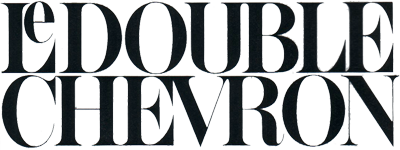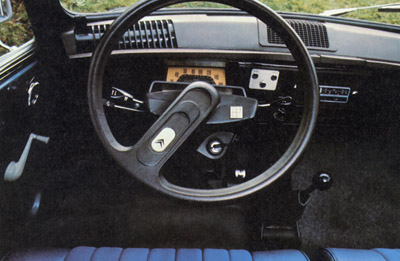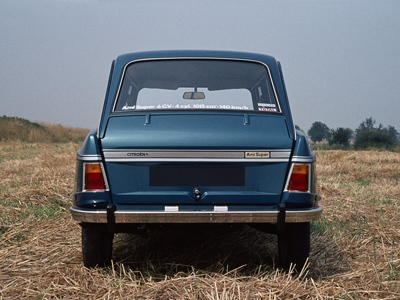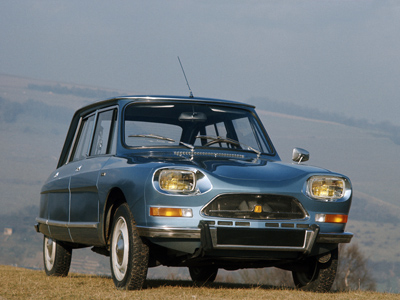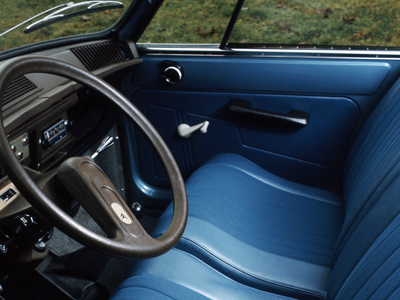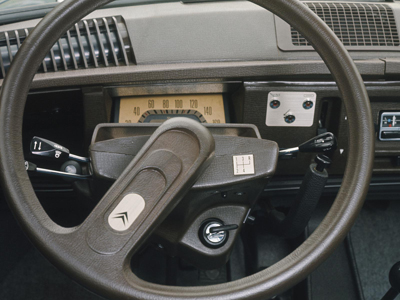
|
Introduced in 1960 with its cap on back to front (the rear of
the roof projecting like a cap-peak over the reversed-slope rear
window), the AMI 6 already had its steady basic characteristics which
were never to change
(front wheel drive, independent wheel suspension with a longitudinal
helicoidal-spring, dashpot, rack and pinion steering); hence the
essential qualities which were to build up its reputation:
unimpeachable road holding, faultless safety and enviable comfort
(gentle suspension, spacious cabin, etc.), to which must be added:
ruggedness, ease of maintenance and running economy. During the year
1966, it was the most-sold vehicle in France. In 1964 an estate version
came to join the saloon; proving yet more adaptable than the latter, it
was soon to supplant it where sales percentages were concerned.
Originally fitted with flat-twin, air-cooled 602 cc. engine, developing
29 h.p. DIN at 4,500 r.p.m. with an engine torque of 28.9 lb.ft at 2800
r.p.m., the first of the AMI 6s could do 65 m.p.h. Certain customers
wanted something faster and better, judging that the car’s basic
qualities could easily accommodate higher power. They were deemed
right, and given satisfaction, in May 1968 with a 602 cc. engine of the
same type, but developing 32 h.p. DIN at 5,750 r.p.m., with a torque of
30.4 lb.ft at 4,000 r.p.m. This allowed it to do 76.5 m.p.h.
In March 1969, the AMI 6 was to become the AMI 8, acquiring a new body
with cleaner, more aerodynamic lines. The saloon thus lost its inverted
rear window
(which was far from getting all the votes, as shown by the success of
the estate model, whose rear design was more classic).
Today the AMI is undergoing a yet more important transformation. Its
body will remain unchanged, but what is hidden under the bonnet will
make it leap forwards: to the well known series of AMI 8s is now added
the AMI Super, a model fitted with a new GS-type flat-four, air-cooled
engine with two overhead camshafts driven by notched belts. The new
capacity is 1015 cc., delivering an effective 53.5 h.p. DIN at 6,500
r.p.m., with a maximum DIN torque of 59.9 lb.ft at 3,500 r.p.m. By
comparison with the AMI 8, the AMI Super therefore has a rise in power
of 21.5 h.p. DIN, and an increase in torque of 19.5 lb.ft DIN. Faster,
it will do (and in fact exceed) 87 m.p.h. (on half load). Livelier
also, it reaches 100 kilometers per hour in 18 seconds, covers 400
meters from a standing start in 20.4 seconds, and 1000 meters in 38.6
seconds.
Its DIN consumption is 9.29 litres per 100 kilometers (30.5 m.p.g.)
Its French Treasury rating is 6 CV.
A revolutionary version of the AMI 8, the AMI Super, has, of course, a
GS-type engine, snappier and more powerful than that of its elder, more
sedate, sister.
But there is more in it than meets the eye: there is in fact a new car
hiding under the now classic coachwork.
First the engine: it is modern, compact and built of light alloy.
Made up of two halfcasings of pressure-cast aluminium for the
crankshaft, it is tilted 9 deg backwards from the horizontal. It is, a
flat-four with two opposed banks of two cylinders each (the best layout
for working balance). Swept volume 1015 cc. Bore 75 mm – (stroke) 59
mm. Cylinder heads are of cast aluminium, with hemispherical combustion
chambers and external inlet pipes of steel, and a light alloy inlet
manifold preheated by exhaust gases. Inlet and exhaust timing is by
means of rocker-controlled “V” valves set at 70 deg, two per cylinder,
with two overhead camshafts (one per cylinder head) driven by notched
belts ensuring strict timing and silent operation. Cooling is by air
thrown back by a plastic fan mounted at the forward end of the
crankshaft. The advantages of air cooling are well known: no connecting
hoses, no radiator, reduced risks of failure, an engine which fears
neither cold (no anti-freeze) nor heat and is "rarin to go" at any
time. Another now well-known fact is that its sole drawback, noisy
operation, has been completely eliminated from the GS engine which
henceforward powers the AMI Super.
But CitroŽn cannot just be satisfied with fitting a new engine
developing 53.5 h.p. DIN on an existing model. All mechanical parts
have been re-designed in accordance with new performance figures.
Quite obviously, the gear-box, now of the GS type with four syncromesh
forward speeds and floor gear lever (no longer with a gear lever on the
fascia as in the AMI 8), is new.
The mitregearing (sic) ratio is 8/33.
And, what is more:
-
The chassis platform is much more strongly built.
-
The brakes are large-dimension, with GS 1220-type discs on
forward wheels, cooled by blown air; rear-wheel drum brakes with
braking-limiter geared to load.
-
Steering (new design) combines ease of action with
accuracy; it is fitted with a two-coupling safety column, and a smaller
diameter foam covered wheel similar to that of the GS.
-
Suspension: new spiral springs, four quick-acting
hydraulic buffers, reacting to the slightest degree of variation in the
suspension arm, and two anti-roll bars.
|
